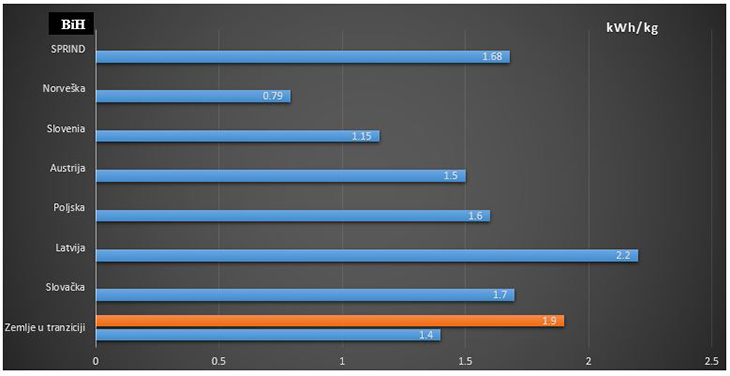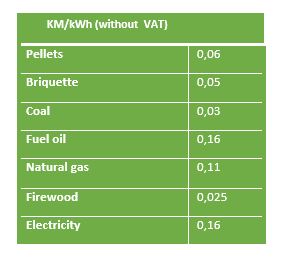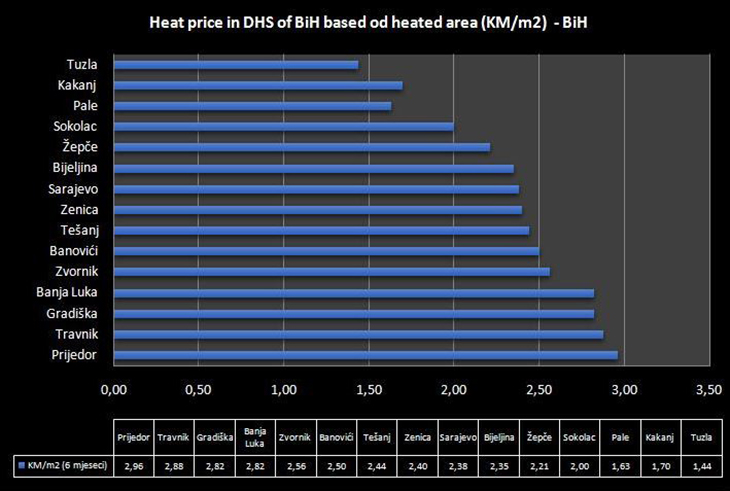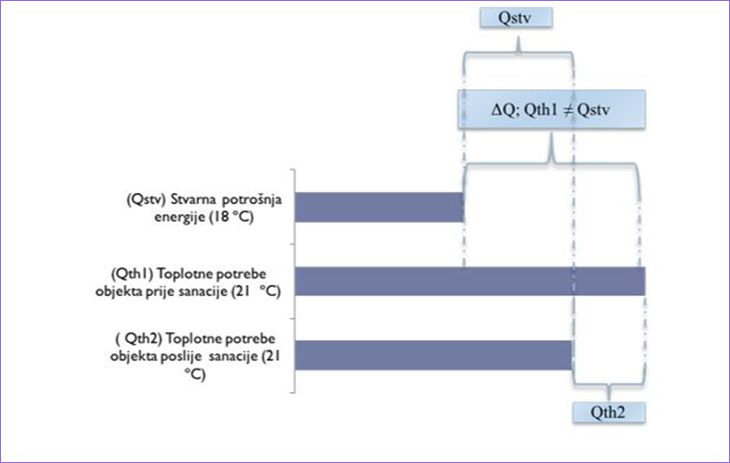
Share
Share
Author: Nihad Harbaš, Energy and climate change consultant
BiH: Are end users still wasting energy?
Specific energy consumption of heat energy and electricity is still quite high in Bosnia and Herzegovina compared to developed and some developing countries. Proof for that is the specific energy consumption in the country in various sectors such as building sector, industry and other ones. this being supported by the indicators (kWh/m2 year, kWh/ person; kWh/kg product, etc.). The building sector, which accounts around 50% of total final energy consumption in Bosnia and Herzegovina, consumes around 160-180 kWh/m2 of heat energy annually, which is three to four times more than in developed countries and emerging standards (i.e. Energy Performance Building Directive whose provisions BiH lowered in its legislation at the entity level). The reason for high consumption lies in the fact that the building sector in BiH is collapsing as the residential and non-residential buildings were built at the times of relatively low energy prices, no concerns about costs and energy characteristics of the buildings.
Overview of the building sector in BiH
As a result of this situation in BiH, residential and non-residential buildings have extremely large glazed areas with high coefficient of heat transfer – “U” value (single or double-glazing), facades with no insulation and large amounts of damage, oversized and unbalanced heating/cooling systems without regulation, etc. All of this leads to high heat losses during heating season or gains during summer. Efficiency of the devices for converting energy are very low and devices are susceptible to the human factor, which increases energy consumption and costs. Manual control of thermo-technical systems is strongly represented in BiH, where human factor stongly influences energy consumption. The solution is in automation.
In addition, thermal comfort is not achieved, and energy efficiency without achieving it is nothing but a waiver or saving energy at the expense of comfort, which is not the goal.

Figure 1. Thermal imaging and capture of the outer shell of the building and the heating system/body of heating
* All photos are made personally by the author of this article on real examples in BiH
Industry
Industry in BIH is not so much developed, and the sector accounts about 25% of energy consumption. However, BIH companies are very energy intensive, which means they are spending a lot of energy per unit of product (kWh/kg).

Figure 2. Specific energy consumption in the food industry per unit of product
*Data taken from a report by Eurostat and energy audits in BiH by the author
Consequences
These facts indicate that there is still high specific energy consumption in all sectors in BIH, resulting in high costs, and point to the fact that the potential for savings is very high.
The conclusion is that energy consumption in Bosnia and Herzegovina has increased.
This primarily refers to the last decade. A further increase in energy consumption is predicted in the coming period. Consumption growth is expected, but the rational use of resources and energy is something that is growing concern in BIH. From an economic point of view of consumers, the fact that energy prices are accompanied by an increase in energy consumption is very unfavourable. With tendency of growth in energy prices and energy it is more than reasonable to devote greater attention to energy saving options, and thus reduce costs and reduction of greenhouse gases, i.e. mitigating climate change, when it comes to global level.
How much does energy price in BiH affects the awareness of users?
The price of energy is a very important factor in the economic and financial calculations of energy efficiency projects planning and implementation. High energy prices are one of the main reasons for increased applications of energy efficiency measures and faster cost effectiveness or shorter period of return on investment. Overview of the prices of energy in BiH (Table 1.) clearly shows that the most economical heat is achieved by using solid fuels, mainly firewood, coal, briquettes and pellets. Using this resources, a significant financial savings in the implementation of energy efficiency measures cannot be achieved, because the population in the country is still not motivated to implement energy efficiency measures. Where more expensive fuels are used, higher profitability can be achieved (period of return in a shorter period of time; 3- 5 years), and with that energy efficiency measures can be implemented.

Table 1. Prices of primary energy forms in Bosnia and Herzegovina (taking the average value of calorific power)
Data taken from copyright works/audits in buildings and the Report of DERK for 2015. (for electrical energy)
The price of electricity for households in Bosnia and Herzegovina (2.5 to 5.0 MWh of annual consumption) in 2015 amounted to 0.16 KM/kWh, and in industry (500-2000 MWh of annual consumption) 0.12 KM/kWh, while, for example in Sweden during the same period the price for households was 0.36 KM/kWh, and for industry 0.13 KM/kWh. These figures show that the industry in the developed countries, such as Sweden, sets as a priority, because the costs of energy in industrial enterprises are one of the keys for growth, development and sustainability of the sector. Developed industries will employee people who will later be able to pay slightly higher energy costs due to higher unit price for households. On the other hand, households, and end users will have more incentive to save energy and costs by implementing energy efficiency measures.
District heating system in BiH
District heating systems in BIH represent a special aspect of energy. Over 80% of the housing stock that is consuming thermal energy from a district heating system, is paying energy costs with a flat rate or per m2 of heated area. This means that public or private companies delivering thermal energy are acting on the principle of production and delivery of energy (MWh) and “tariff system” payment on KM/m2. Approximately 20% of the housing sector in BiH connected to the district heating system, pays energy according to the consumption where individual heating plants have their own tariff rates. What is missing is the definition or creation of tariffs delegated from higher levels of government. A unique Law on the production, distribution and supply of heating energy needs to be established.
As a precondition to motivate end users to save energy for heating is to allow payments per consumption, which is clearly defined in EU directives. Payment for consumed thermal energy does not mean the consumer will be paying less; it means the consumer will be paying according to the consumed amount of energy.

Figure 3. Heat price in DHS in BiH based on heated area (KM/m2)
*Prices based on the information available to the author
Is the goal of BiH rehabilitation, raising comfort or saving energy and money by implementing EE measures?
Measures of energy efficiency in principle aim to reduce energy consumption, costs, and greenhouse gas emissions, which is the primary goal. However, co-benefits arising from the implementation of energy efficiency measures are numerous, and sometimes perhaps even more important than their primary objective. Given the state of the buildings in Bosnia and Herzegovina, their dilapidation, decrepitude, and other consequences of natural or other causes (especially from the nineties of the last century in the Balkans), energy efficiency is an ideal opportunity for the restoration of buildings and general improvement of the situation in the sector. In many buildings, both residential and public buildings, in BiH in general, thermal comfort cannot be achieved because the heat losses are so high that cannot be overcome only by heating or cooling systems, they needs reconstruction, which often does not result in energy and financial benefits.
For example, there are public buildings where children spend their time or infirm persons, and where thermal comfort cannot be achieved. This means that the temperature of the interior space should be at 21/22 °C (depending on the purpose of the building), but due to the above facts, this temperature cannot be achieved, it remains at 16/17 °C. The implementation of energy efficiency measures on the subject building could have a so-called rebound effect. A rebound effect occurs when after implementing energy efficiency measures, no savings in energy or money is achieved, but sometimes energy consumption is even higher. However, some other positive effects are achieved, such as raising thermal comfort, renovation, extension of its useful life, etc. In such cases, it is very difficult to financially justify energy efficiency projects or to find an investor. Technically, all calculations are performed for a condition that is mutually comparable, that is before and after implementation of EE measures thermal comfort achieved. In such cases, the appearance of deviations must be detailed and solution must be find.

Figure 4. Rebound effect in the implementation of measures of energy efficiency in buildings
The diagram clearly illustrates that in the conditions prior to the rehabilitation of the building, thermal comfort is not achieved and the average temperature inside the building is 18 °C. To define savings after implementation of EE measures, it is assumed that the comfort is reached or that the temperature of the interior space is 21 °C. With same assumption is taken for the analysis after implementation of energy efficiency measures. However, there is an anomaly that after the implementation of EE measures the same or greater amount of energy (rebound effect) is consumed. This suggests that savings are not achieved, but thermal comfort is reached, the building service life extended to improve the social, and often health, state of the user. Of course, this is not the case for every building, but it is a frequently occuring challenge in BiH.
Who is funding projects of energy efficiency in BIH and who are the beneficiaries?
Energy efficiency projects, in principle, should be financed by users or final consumers of energy. For a number of reasons. First of all because of the financial benefits, followed by wider social benefits in terms of reducing air pollutants, such as particulate matter and other local pollutants, a problem that majority of towns in Bosnia and Herzegovina face; the reduction of GHG emissions also. This would in general constitute climate change mitigation which is reality of the 21st century which we all face.
The motive of end users in BIH is not on satisfactory level, especially as the price of energy is still low. Due to disorganized market and regional and world influence, the deviation in energy prices and energy is constantly coming. This is best reflected in the prices of natural gas, oil, or last year, biomass – pellets.
To motivate end users, a number of international organizations operating in Bosnia and Herzegovina, through their programs provide funds to finance energy efficiency measures. Apart from them, domestic institutions are investing some effort in order to improve the current situation. It has been invested about USD 100 million in direct and indirect energy efficiency measures during last 6-7 years through international and local projects. There are several funds currently in the process of establishment. such as fund for environmental protection and energy efficiency, which is, perhaps, in the Federation one of the largest sustainable financiers of whole process of environmental protection and energy efficiency improvement. In addition, there are credit and budgetary funds, but also funds already mentioned, the international organizations that are primarily focused on so-called soft measures. Of course, the private capital plays a major role. Business models such as ESCO (Energy Service Company) or PPP (Public Private Partnership) are becoming more and more attractive for private investors.
In order to attract more investment in energy efficiency projects, it is necessary to pull in private capital, and employ domestic labour. Plenty of good examples in BiH have been executed all in the area of energy efficiency of the public sector by improving the building envelope, heating system, replacement of old boilers using fossil fuels with new ones using renewables such as biomass – pellets, wood chips, etc. More than 100 MW of boiler capacity have been installed in the public sector in BIH, whereas the boilers have been produced locally. The combination of the above mentioned measures with the participation of private capital is technically feasible, financially justifiable, socially beneficial and environmentally acceptable. In addition, a complete supply chain is locally closed, which contributes to new employment of local labour force, economic growth and sustainable development of the community.
All these are preconditions for achieving the full effect that delivers energy efficiency.
Is general public in BiH really aware of this issue?
To make energy efficiency experience a real expansion, most important players have to be basic wheel of the story, especially those who consume the most energy – citizens or the general public. Currently in BiH public is not informed about this issue, and so they are not part of the process. Their involvement can be achieved by the “carrot and stick” approach. The principle of carrot will allow them to co-finance or specific subsidies when implementing energy efficiency measures through grant or favourable loans. One example in BiH is co-financing material for thermal insulation to the outer envelope of the building, provided through international organizations, and single preparation, execution and other necessary actions realized by the end user. The ratio of the costs of this measure was 20:80%, where 80% were labour costs, preparation, etc. This is an example of the “carrot and stick” approach.
The principle of the stick are regulations and laws issued by the authorities of the governments in the form of minimum requirements for thermal protection and rational use of energy, labeling household appliances, discharge from the use of and trade incandescent light bulbs, etc.
A winning combination is a combination of carrot and stick. Europe has been going in that direction for decades. General public have to be inform on benefits and opportunities where media play such important role.
In the same way as BiH’s path to EU membership has no alternative, the way to rational use, clean production and use of energy in BiH, has no alternative,









Be the first one to comment on this article.